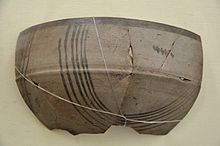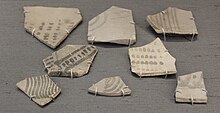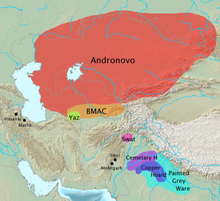 Map of some Painted Grey Ware (PGW) sites Map of some Painted Grey Ware (PGW) sites | |
| Geographical range | North India Eastern Pakistan |
|---|---|
| Period | Iron Age |
| Dates | c. 1200–600 BCE |
| Major sites | Hastinapur Mathura Ahichchhatra Panipat Jognakhera Rupnagar Bhagwanpura Kosambi |
| Characteristics | Extensive Iron metallurgy Fortified settlement |
| Preceded by | Cemetery H culture Black and red ware Ochre Coloured Pottery culture |
| Followed by | Mahajanapadas |
The Painted Grey Ware culture (PGW) is an Iron Age Indo-Aryan culture of the western Gangetic plain and the Ghaggar-Hakra valley in the Indian subcontinent, conventionally dated c.1200 to 600–500 BCE, or from 1300 to 500–300 BCE. It is a successor of the Cemetery H culture and Black and red ware culture (BRW) within this region, and contemporary with the continuation of the BRW culture in the eastern Gangetic plain and Central India.

Characterized by a style of fine, grey pottery painted with geometric patterns in black, the PGW culture is associated with village and town settlements, domesticated horses, ivory-working, and the advent of iron metallurgy. As of 2018, 1,576 PGW sites have been discovered. Although most PGW sites were small farming villages, "several dozen" PGW sites emerged as relatively large settlements that can be characterized as towns; the largest of these were fortified by ditches or moats and embankments made of piled earth with wooden palisades, albeit smaller and simpler than the elaborate fortifications which emerged in large cities after 600 BCE.
The PGW Culture probably corresponds to the middle and late Vedic period, i.e., the Kuru-Panchala kingdom, the first large state in the Indian subcontinent after the decline of the Indus Valley civilisation. The later vedic literature provides a mass of information on the life and culture of the times. It is succeeded by Northern Black Polished Ware from c.700–500 BCE, associated with the rise of the great Mahajanapada states and of the Magadha Empire.
Dating
The Painted Grey Ware culture (PGW) is conventionally dated c.1500 to 500 BCE.
Akinori Uesugi regards PGW as having three periods within North Indian Iron Age which are:
- Period I (c. 1300–1000 BCE)
When it makes its appearance in the Ghaggar valley and the upper Ganga region.
- Period II (c. 1000–600 BCE)
When it spreads into the western part of the Ganga valley.
- Period III (c. 600–300 BCE)
With interactions to the east.
Recent Archaeology
Two periods of PGW were identified recently at Ahichhatra by archaeologists the earliest from c. 1500 to 800 BCE, and the late from 800 to 400 BCE.
Overview




The PGW culture cultivated rice, wheat, millet and barley, and domesticated cattle, sheep, pigs, and horses. Houses were built of wattle-and-daub, mud, or bricks, ranging in size from small huts to large houses with many rooms. There is a clear settlement hierarchy, with a few central towns that stand out amongst numerous small villages. Some sites, including Jakhera in Uttar Pradesh, demonstrate a “fairly evolved, proto-urban or semi-urban stage” of this culture, with evidence of social organization and trade, including ornaments of gold, copper, ivory, and semi-precious stones, storage bins for surplus grain, stone weights, paved streets, water channels and embankments.
The plough was used for cultivation. There are also indications of growing complexity of society as population increased and the size and number of settlements multiplied. Arts and crafts of the PGW people are represented by ornaments (made from terracotta, stone, faience, and glass), human and animal figurines (made from terracotta) as well as "incised terracotta discs with decorated edges and geometric motifs" which probably had "ritual meaning," perhaps representing symbols of deities. There are a few stamp seals with geometric designs but no inscription, contrasting with both the prior Harappan seals and the subsequent Brahmi-inscribed seals of the Northern Black Polished Ware culture.
The PGW pottery shows a remarkable degree of standardization. It is dominated by bowls of two shapes, a shallow tray and a deeper bowl, often with a sharp angle between the walls and base. The range of decoration is limited - vertical, oblique or criss-cross lines, rows of dots, spiral chains and concentric circles being common.
At Bhagwanpura in the Kurukshetra district of Haryana, excavations have revealed an overlap between the late Harappan and Painted Grey Ware cultures, large houses that may have been elite residences, and fired bricks that may have been used in Vedic altars.
Fresh surveys by archaeologist Vinay Kumar Gupta suggest Mathura was the largest PGW site around 375 hectares in area. Among the largest sites is also the recently excavated Ahichatra, with at least 40 hectares of area in PGW times along with evidence of early construction of the fortification which goes back to PGW levels. Towards the end of the period, many of the PGW settlements grew into the large towns and cities of the Northern Black Polished Ware period.
Interpretations
The pottery style of this culture is different from the pottery of the Iranian Plateau and Afghanistan (Bryant 2001). In some sites, PGW pottery and Late Harappan pottery are contemporaneous. The archaeologist Jim Shaffer (1984:84-85) has noted that "at present, the archaeological record indicates no cultural discontinuities separating Painted Grey Ware from the indigenous protohistoric culture." However, the continuity of pottery styles may be explained by the fact that pottery was generally made by indigenous craftsmen even after the Indo-Aryan migration. According to Chakrabarti (1968) and other scholars, the origins of the subsistence patterns (e.g. rice use) and most other characteristics of the Painted Grey Ware culture are in eastern India or even Southeast Asia.
Recent research
In 2013, the University of Cambridge and Banaras Hindu University excavated at Alamgirpur near Delhi, where they found a period overlap between the later part of the Harappan phase (with a "noticeable slow decline in quality") and the earliest PGW levels; Sample OxA-21882 showed a calibrated radiocarbon dating from 2136 BCE to 1948 BCE, but seven other samples from the overlap phase that were submitted for dating failed to give a result. A team of the Archaeological Survey of India led by B.R. Mani and Vinay Kumar Gupta collected charcoal samples from Gosna, a site 6 km east of Mathura across the Yamuna river, where two of the radiocarbon dates from the PGW deposit came out to be 2160 BCE and 2170 BCE, but they mention that "there is a possibility that the cultural horizon which is now regarded as belonging to the P.G.W. period might turn out to be as belonging to a period with only plain grey ware." Later on, other two datings confirming early PGW horizon in Kampil excavations were published as 2310 +/- 120 BCE and 1360 +/- 90 BCE by archaeologist D.P. Tewari.
Excavation at Anuradhapura in Sri Lanka has unearthed PGW pottery from the 'Basal early historic' period of Anuradhapura (600 BC-500 BCE) showing connections with North India.
See also
Notes
- Petrie et al. (2019) mention 1500 to 700 BCE.
- See also Indo-Aryan migration#Archaeological evidence.
References
- ^ Douglas Q. Adams (January 1997). Encyclopedia of Indo-European Culture. Taylor & Francis. pp. 310–. ISBN 978-1-884964-98-5.
- ^ Kailash Chand Jain (1972). Malwa Through the Ages, from the Earliest Times to 1305 A.D. Motilal Banarsidass. pp. 96–. ISBN 978-81-208-0824-9.
- Possehl, G. L., (2002). The Indus civilization: A contemporary perspective, AltaMira Press, Walnut Creek, CA; Oxford, p. 29.
- Bates, J., (2020). "Kitchen gardens, wild forage and tree fruits: A hypothesis on the role of the Zaid season in the indus civilisation (c.3200-1300 BCE)", in Archaeological Research in Asia 21 (2020), Table 1, p.2.
- Uesugi, Akinori, (2018). "An Overview on the Iron Age in South Asia", in (ed.) Akinori Uesugi, Iron Age in South Asia, Kansai University, Fig. 6, pp. 9–12.
- Southworth, Franklin, (2005). Linguistic Archaeology of South Asia, Routledge, p. 177.
- De Laet, Sigfried J.; Herrmann, Joachim (January 1996). History of Humanity: From the seventh century B.C. To the seventh century A.D. ISBN 9789231028120.
- Mallory, J. P.; Adams, Douglas Q. (1997). Encyclopedia of Indo-European Culture. ISBN 9781884964985.
- Uesugi, Akinori (2018). "A Study on the Painted Grey Ware", in Heritage: Journal of Multidisciplinary Studies in Archaeology 6 (2018), p. 2.
- James Heitzman, The City in South Asia (Routledge, 2008), pp. 12–13.
- Geoffrey Samuel, (2010) The Origins of Yoga and Tantra: Indic Religions to the Thirteenth Century, Cambridge University Press, pp. 45–51.
- Michael Witzel (1989), Tracing the Vedic dialects in Dialectes dans les litteratures Indo-Aryennes ed. Caillat, Paris, 97–265.
- Uesugi, Akinori, (2018)."An Overview on the Iron Age in South Asia", in (ed.) Akinori Uesugi, Iron Age in South Asia, Kansai University, Fig. 6, pp. 9-12.
- Pokharia, Anil K., Chanchala Srivastava, Bhuvan Vikram, et al. (2015). "On the botanical findings from excavations at Ahichchhatra: a multicultural site in Upper Ganga Plain, Uttar Pradesh", in Current Science, Vol. 109, No. 7, 10 October 2015, p. 1301.
- Neogi, Sayantani, Charles A. I. French, Julie A. Durcan, Rabindra N. Singh, and Cameron A. Petrie, (2019). "Geoarchaeological insights into the location of Indus settlements on the plains of northwest India", in Quaternary Research, Volume 94, March 2020, p. 140.
- Singh, Upinder (2009), A History of Ancient and Medieval India: From the Stone Age to the 12th Century, Longman, Delhi, pp. 246–248
- ^ Kenoyer, J. M., (2006), "Cultures and Societies of the Indus Tradition. In Historical Roots" in the Making of ‘the Aryan’, R. Thapar (ed.), National Book Trust, New Delhi, pp. 21–49.
- Bridget and Raymond Allchin (1982). The Rise of Civilization in India and Pakistan. Cambridge University Press.
- ^ Gupta, Vinay Kumar, (2014)."Early Settlement of Mathura: An Archaeological Perspective", An Occasional paper, in History and Society, New Series 41, Nehru Memorial Museum and Library, New Delhi, pp. 1-37.
- Mani, B. R., (September 17, 2013). "What Lies Beneath", in Educational Times.
- "Archived copy" (PDF). Archived from the original (PDF) on 1 January 2014. Retrieved 4 January 2014.
{{cite web}}: CS1 maint: archived copy as title (link) - Shaffer, Jim. 1993, Reurbanization: The eastern Punjab and beyond. In Urban Form and Meaning in South Asia: The Shaping of Cities from Prehistoric to Precolonial Times, ed. H. Spodek and D.M. Srinivasan.
- "Archived copy" (PDF). Archived from the original (PDF) on 23 May 2013. Retrieved 13 February 2013.
{{cite web}}: CS1 maint: archived copy as title (link) - Singh, R.N., Cameron Petrie et al., (2013). "Recent Excavations at Alamgirpur, Meerut District: A Preliminary Report", in Man and Environment 38(1), pp. 32-54.
- Tewari, D.P., (2014). "The Ceramic Traditions from Kampil Excavations", in Puratattva No.44, pp.194-207.
- Tyagi, Manisha (2006). "Commercial Relations Between North India and Sri Lanka in Ancient Period: A Study". Proceedings of the Indian History Congress. 67: 106–117. ISSN 2249-1937. JSTOR 44147927.
Further reading
- Bryant, Edwin (2001). The Quest for the Origins of Vedic Culture. Oxford University Press. ISBN 0-19-513777-9.
- Chakrabarti, D.K. 1968. The Aryan hypothesis in Indian archaeology. Indian Studies Past and Present 4, 333–358.
- Jim Shaffer. 1984. The Indo-Aryan Invasions: Cultural Myth and Archaeological Reality. In: J.R. Lukak. The People of South Asia. New York: Plenum. 1984.
- Kennedy, Kenneth 1995. "Have Aryans been identified in the prehistoric skeletal record from South Asia?", in George Erdosy, ed.: The Indo-Aryans of Ancient South Asia, p. 49–54.
External links
Categories:- Iron Age cultures of South Asia
- Prehistoric Pakistan
- Prehistoric India
- Iron Age cultures of Asia
- 13th-century BC establishments
- 2nd-millennium BC establishments in India
- 6th-century BC disestablishments in India
- Archaeological cultures in India
- Indo-Aryan archaeological cultures
- Archaeological sites in Rajasthan
